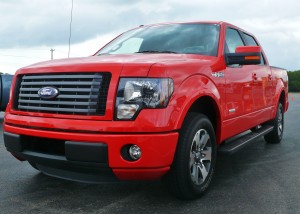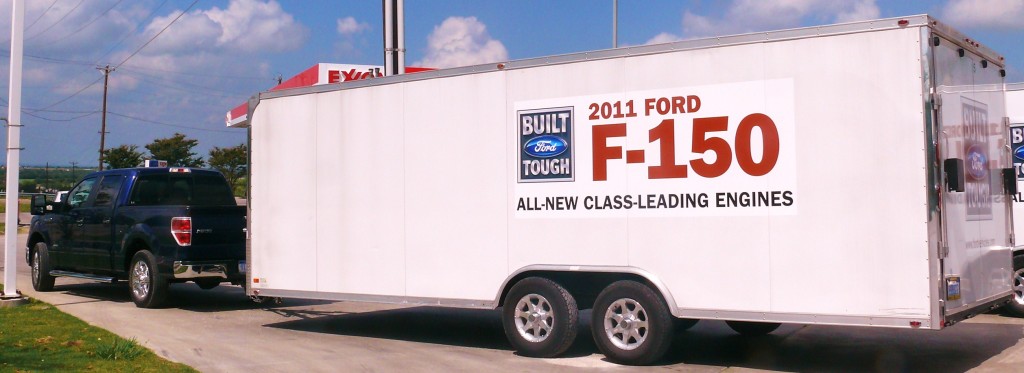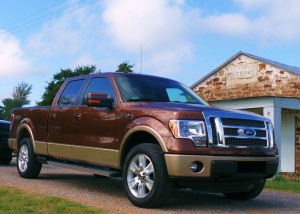EcoBoost paces F150’s 4 new engines
By John Gilbert
FORT WORTH, TEXAS — When Ford redesigned its popular F150 pickup truck, it connected every objective to maintain its 33-year-old title as largest-selling vehicle in the U.S. The assorted V6 and V8 engines Ford offered in the half-ton pickups seemed adequate enough, but Ford decided it could upgrade all of them for 2011.
Riding the crest of a technical wave, Ford is offering four new engines in the F150, starting with a base 3.7-liter V6, then to a high-revving 5.0 V8 adapted from the Mustang GT, and up to the 6.2 V8 built for the larger SuperDuty pickups. The coup de grace is the smallest but arguably the most potent — the 3.5-liter EcoBoost V6, which is aimed at convincing truck buyers that refining and turbocharging the smallest-displacement offering results in far more than just “the little engine that could.”
Distinctive for its new horizontal-bar grille, all four engines have specific purposes, and all represent a shift to high-tech powerplants that are both more powerful and more economical. Ford unveiled the new arsenal in Fort Worth, Texas, where waves of media showed up to drive them through various tests against top opposition from Chevrolet and Dodge on area highways and freeways, including competitive towing and handling exhibitions.
The daylong procedure ended with an electronically timed series of drag races at Texas World Speedway, a multipurpose motorsports park located on the Fort Worth side of the Dallas-Fort Worth — which are the twin cities, Texas style. But first, journalists were paired with engineers for each of four specific segments. One was when to drive different Ford F150s against the Chevrolet and Dodge competitors, towing identical trailers.
While it wasn’t a set-up, Ford’s confidence that it would prevail was well-founded. My most impressive moment, though, was improvised, while driving along in an F150 on a freeway stretch, where the truck, with its unique trailering-assist technology, handled the chore with surprising ease. Cruising along in fairly heavy traffic, I suddenly saw a large chunk of separated tire tread peeled off from a semi’s retread, covering almost my entire right lane. Knowing there was no traffic immediately beside me, I instinctively swerved hard to the left, straightening out easily, then completing my maneuver by easing back into the right lane. It wasn’t until I was going straight in the right lane again that I realized I had completed a tactical emergency-avoidance maneuver in a large pickup with a huge trailer. And I did it as smoothly and easily as if I’d been driving a sporty sedan.
Ford has become the first manufacturer to install electric power-steering assist on all its trucks, which improves steering quickness, as well as steering precision, with just enough steering effort to avoid a too-light feel. The trucks also have a 6-speed automatic transmission with SelectShift, which has progressive range selection that allows you to downshift a gear or two, and leave the truck using, say, first through fourth rather than sixth to ease towing requirements. An integrated software with electronic control mode is particularly noticed in tow-haul mode. Combining those assets makes tuning the steering, the revised suspension, and the transmission for a coordinated feel of stability. Ford also has instituted drift control on the steering system, an electronic aid that centers the steering wheel and virtually corrects what otherwise might be a harsh reaction to road irregularities.
Ford has improved the interiors of all its F150 models. While the design of the controls and instrumentation is impressive in the Dodge and Chevrolet as well, and becomes a subjective thing, it is safe to say that Ford doesn’t trail anybody in interior amenities with the new truck — particularly with the addition of its SYNC connectivity for electronic gadgetry.
All the Ford trucks were tested extensively, in real-world as well as on a chassis dynamometer. One test duplicated time and distance required to make a highway pass while towing a 10,000-pound trailer, and it was notable in comparing the new EcoBoost twin-turbocharged V6. The test calls for pulling out into the left lane, accelerating from 40-70 mph to pass, and then pulling back into the right lane. The Chevrolet Silverado with the 5.3 V8 covered the distance in 19.23 seconds, and improved it to 19.11 seconds, covering 0.29 of a mile; the Dodge Ram Hemi did it in 17.91 seconds, using the same 0.29 of a mile; the Ford F150 EcoBoost did it in 14.26 seconds, using only 0.22 miles.
With that information in mind, we returned to Texas World Speedway for the climactic drag races. Ford had arranged and eighth-mile strip in the parking lot, with actual starting lights that showed staging, then three amber lights before the green start signal, and the strips even had finishing lights, and elapsed-timers — just like a real drag-race setting. There were probably 25 or more runs on each of the assembled trucks, which included three Chevys, one Dodge Ram Hemi, and an array of Ford F150s with the 3.7, 5.0, 6.2, and the 3.5 EcoBoost.
The best run in any of the Chevys was in the 5.3 V8-powered Silverado, at 9.308 seconds and 64.20 mph. The Dodge Hemi beat it, at 8.864 seconds and 66.97 mph.
I started working through the F150s with the 3.7-liter V6 F150, and clocked a 9.472-second run, at 64.32 mph. That was third best elapsed time of all the 3.7 runs, where a 9.427 elapsed time was the best, although my finishing speed beat the 64.20 mph standard. In the 5.0 V8, my 8.916-second run, at 66.97 mph,was fifth best, with the best an 8.845-second dash at 68.87 mph. In the 6.2 V8 F150, my 8.970 was only 12th best, at 67.77 mph, with the top time an 8.810. Oddly enough, my 67.77 mph matched the finishing speed of the fastest run.
My best came last, however, when I surprised myself in the EcoBoost F150. My first attempt was an 8.,583-second shot at 69.29 mph, which eclipsed the standard of 8.674. After I ran an 8.748 at 69.29 in the other EcoBoost Ford, I made my final run as a repeat in that first truck, and I clocked an 8.665 seconds — second only to my best run — at 68.59 mph. Two other EcoBoost runs got up to just over 70mph, although nobody from our group beat my best two times.
At the end of the day, I was surprised to learn that among all the runs from all four groups driving all the trucks, the fastest two elapsed times were my two runs in the EcoBoost F150. If Ford was hoping we’d prove that the EcoBoost 3.5 V6 would successfully challenge the larger displacement V8s from Ford and competitors alike, it was convincing evidence.
The 3.7 V6 has 302 horsepower at 6,500 RPMs and 278 foot-pounds of torque at 4,000 RPMs — increases of 100 horsepower and 24 foot-pounds over the outgoing 4.2-liter V6. The 3.7 is standard on the XL, ST, XL, and XLT models, and has a 6,100-pound towing capacity.
The 5.0 V8 is a smooth-revving, high-performance engine with a great audible sensation of its power. It has 365 horsepower at 5,000 RPMs — 50 more than the existing 5.4-liter V8 — and 420 foot-pounds of torque at 2,500 RPMs, with an 11,300-pound towing capacity. With camshaft torque-actuated twin-independent variable valve-timing, it has the ability to open the valves later for more fuel injected under higher load conditions. The 5.0 is standard on XL and Platinum models, and has definite power and torque advantages over the 4.8-liter Chevrolet and 4.7-liter Dodge V8s.
The 6.2-liter V8 comes in the Raptor, or the Lariat Limited, Harley Davidson, Lariat, and Platinum models. With a larger bore and short stroke, and with only two valves per cylinder unlike all the others, it has single overhead camshafts with cam torque-actuated dual and equal variable valve timing. The engine turns out 411 horsepower at 5,500 RPMs and 434 foot-pounds of torque at 4,500 RPMs, and a towing capacity of 11,300 pounds.
Still, the most remarkable of the F150 engines is the 3.5-liter EcoBoost. It has 365 horsepower at 5,550 RPMs, matching the output of the 5.0 V8, and 420 foot-pounds of torque — also matching the 5.0, and it has a listed towing weight of 10,000 pounds. With twin turbochargers, direct injection, and upgraded lower main bearings, as well as altered piston design and a tuned, one-piece composite intake manifold, the dual-overhead-cam 3.5 has Ford’s “next generation” twin independent variable valve timing.
It was interesting to be able to back up the impressive numbers with actual performance runs at Texas World Speedway. Even before the new F150s hit the showrooms, Ford truck manager Frank Davis said that 338,446 F150s have already been sold this year, an increase of 29 percent, while competitors are up only 9 percent.
“We have a 103,000-unit lead over Silverado, and we’ve sold 10,000 more trucks than Silverado and [GMC] Sierra combined,” said Davis. “We also have a faster increase in customer loyalty, with 45 percent-plus. We’ve increased towing, payload, and fuel economy. When we surveyed customers, we found that 70 percent wanted more fuel economy, and 32 percent of that 70 percent said they would switch brands to get a 20-percent improvement in fuel economy. Because Ford has fewer customers asking for more fuel economy, we think we have a better chance for conquest sales.”
Once the new-engined trucks hit the streets, that rate should increase more. Ford anticipates a 20-percent increase in real-world fuel economy, led by the EcoBoost, which can match the power and beat the acceleration of the V8-powered pickups, but deliver the fuel economy of V6es.
Interior features, spelled out by Eric Kuehn, include 110-volt outlets, telescoping steering wheel, high-definition radio, a larger rearview display, integrated key and fob, factory-installed remote start, and a new gauge cluster with an LCD screen for fuel, trip computing, and information. Ford’s SYNC plan, coordinated with Microsoft, also comes on the new F150, and packages include a perimeter alarm, and off-road packages, available on the XLT, Lariat, or King Ranch.
With so many models — XL, STX, XLT, FX2, FX4, Lariat, King Ranch, Platinum, Lariat Limited, and up to the Raptor — and every imaginable configuration of regular cab, extended cab, and crew cab, plus all the option packages such as off-road, as well as 2-wheel drive or 4-wheel drive, Ford is going after every truck customer it can reach.
For a real kick, however, make sure to drive the 5.0 V8 just to listen to the engine howl as it winds up, and make sure to drive the EcoBoost model — just so you know which F150 would win a drag race.
Comments
Tell me what you're thinking...
and oh, if you want a pic to show with your comment, go get a gravatar!






 John Gilbert is a lifetime Minnesotan and career journalist, specializing in cars and sports during and since spending 30 years at the Minneapolis Tribune, now the Star Tribune. More recently, he has continued translating the high-tech world of autos and sharing his passionate insights as a freelance writer/photographer/broadcaster. A member of the prestigious North American Car and Truck of the Year jury since 1993. John can be heard Monday-Friday from 9-11am on 610 KDAL(www.kdal610.com) on the "John Gilbert Show," and writes a column in the Duluth Reader.
John Gilbert is a lifetime Minnesotan and career journalist, specializing in cars and sports during and since spending 30 years at the Minneapolis Tribune, now the Star Tribune. More recently, he has continued translating the high-tech world of autos and sharing his passionate insights as a freelance writer/photographer/broadcaster. A member of the prestigious North American Car and Truck of the Year jury since 1993. John can be heard Monday-Friday from 9-11am on 610 KDAL(www.kdal610.com) on the "John Gilbert Show," and writes a column in the Duluth Reader.